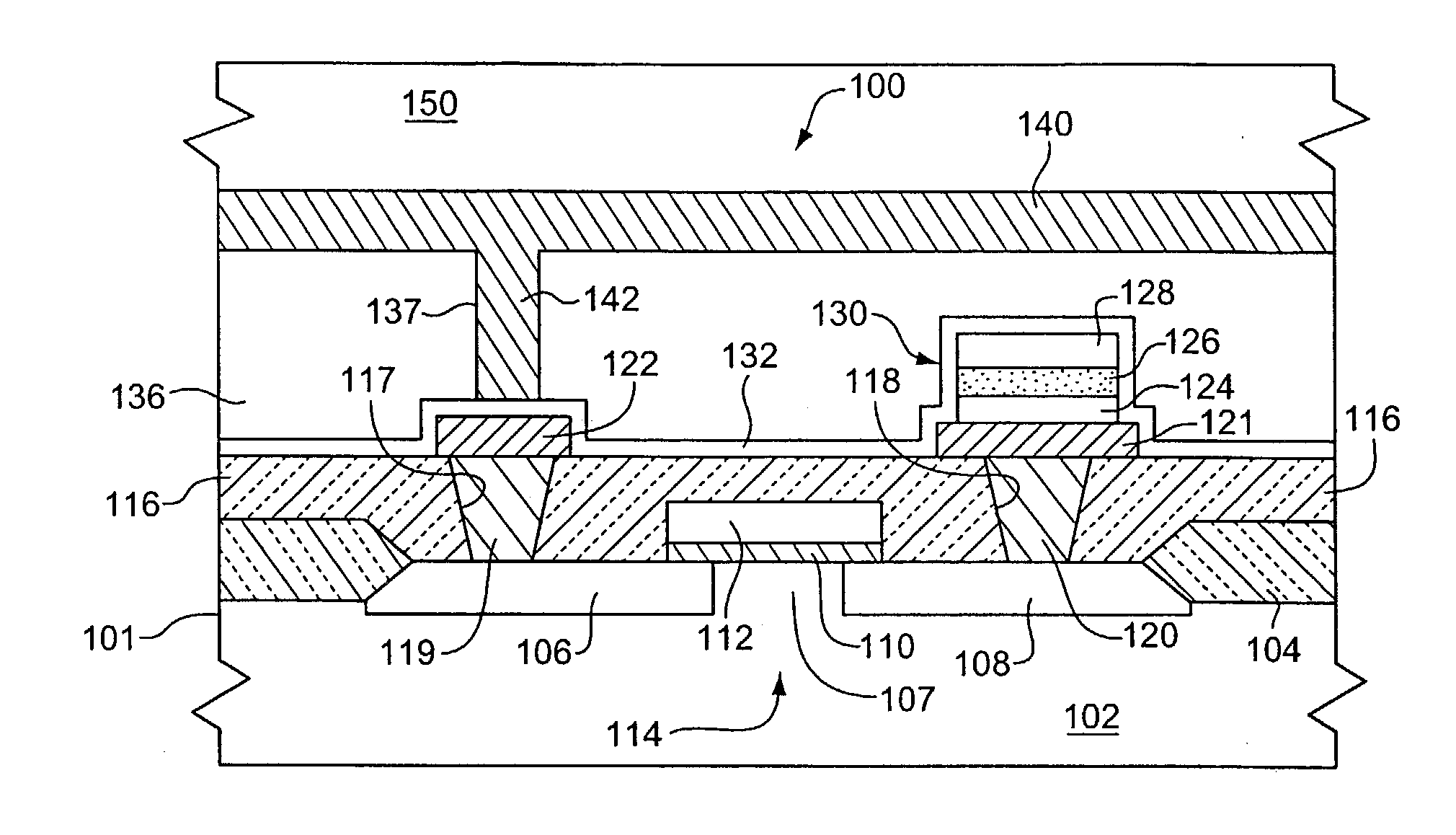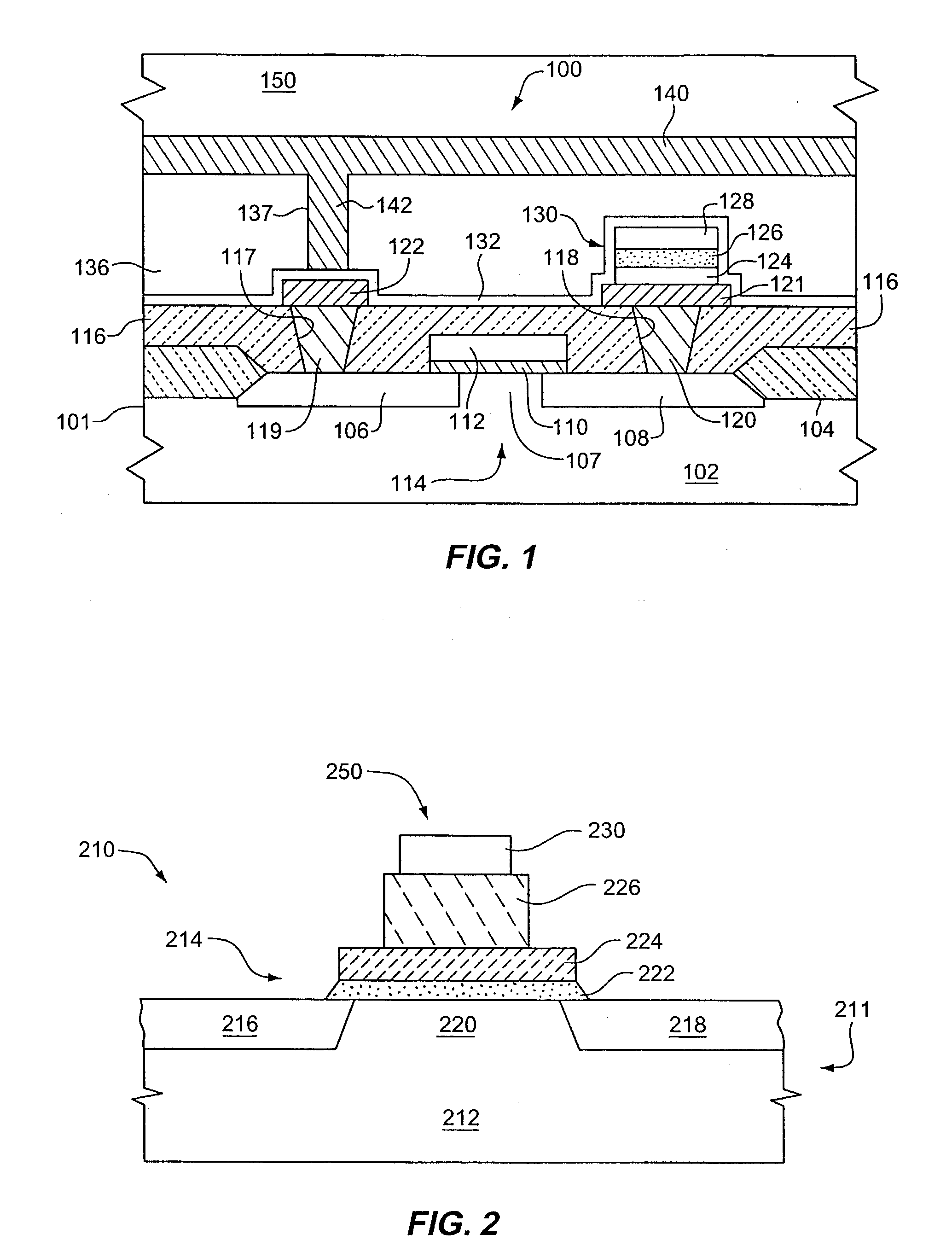Low thermal budget fabrication of ferroelectric memory using RTP
a ferroelectric memory and low thermal budget technology, applied in the direction of polycrystalline material growth, crystal growth process, chemistry apparatus and processes, etc., can solve the problems of deterioration of the electronic characteristics of the mosfet, economic unfeasibility, oxygen damage to the semiconductor substrate and other elements of the cmos circuit,
- Summary
- Abstract
- Description
- Claims
- Application Information
AI Technical Summary
Benefits of technology
Problems solved by technology
Method used
Image
Examples
example 2
[0093] A substrate wafer was prepared and ferroelectric capacitors were fabricated using a low thermal budget in accordance with the invention, as in Example 1, except that the liquid spin-on layer was spun at 2000 rpm instead of 2500 rpm. As a result, the ultra-thin film of SBT layered superlattice material had a thickness of about 35 nm, instead of 25 nm. The polarizability, expressed as the 2Pr-value, of the 35-nm capacitors was about 11.5 .mu.C / cm.sup.2 measured at 3 volts. The 2Pr-value measured at 1 volt was about 10.4 .mu.C / cm.sup.2 . The coercive voltage measured was about 0.3 volts, which corresponds to a coercive field, Ec, of about 170 kV / cm.
example 3
[0094] Ferroelectric capacitors containing an ultra-thin film of SBT layered superlattice material were fabricated using a low thermal budget in accordance with the invention by applying a single spin-on layer of liquid precursor on a substrate prepared as in Example 1. Thus, the cumulative heating time was about 2.5 minutes. The ultra-thin films of SBT had a thickness of about 48 nm. The fabrication conditions are summarized here:
2 Substrate: Si / SiO.sub.2 / Pt Solution: MOD Sr.sub.0.9Bi.sub.2.2Ta.sub.2O.sub.9, 0.08 molar Deposition: Spin-on, 1 layer @ 1500 rpm Baking: 1.sup.st plate @ 160.degree. C. / 1 min. 2.sup.nd plate @ 260.degree. C. / 4 min. Pre-TE RTP: 625.degree. C. / 30 sec. in O.sub.2 TE: 2000A Pt TE / FE etch: Dry etch Post-TE RTP: 750.degree. C. / 120 sec. in O.sub.2 Thermal budget: 118,750.degree. C.-sec
[0095] Another set of ferroelectric capacitors were fabricated in accordance with the invention on another substrate wafer by applying two spin-on layers of liquid precursor solut...
example 4
[0098] Ferroelectric capacitors containing a thin film of SBT layered superlattice material were fabricated using a low thermal budget in accordance with the invention by applying a single spin-on layer of liquid precursor on a substrate prepared as in Example 1. The thin films of SBT had a thickness of about 60 nm. The fabrication conditions are summarized here:
5 Substrate: Si / SiO.sub.2 / Pt Solution: MOD Sr.sub.0.9Bi.sub.2.2Ta.sub.2O.sub.9, 0.1 molar Deposition: Spin-on, 1 layer @ 2000 rpm Baking: 1.sup.st plate @ 160.degree. C. / 1 min. 2.sup.nd plate @ 260.degree. C. / 4 min. Pre-TE RTP: 625.degree. C. / 30 sec. in O.sub.2 TE: 200 nm Pt TE / FE etch: Dry etch Post-TE RTP: 700.degree. C. / 60 sec or 750.degree. C. / 120 sec. in O.sub.2 Thermal budget: 60,750.degree. C.-sec or 108,750.degree. C.-sec
[0099] Thus, the cumulative heating time at elevated temperature was about 1.5 min., or alternatively about 2.5 minutes. Additionally, a set of ferroelectric capacitors was fabricated using a "high t...
PUM
 Login to View More
Login to View More Abstract
Description
Claims
Application Information
 Login to View More
Login to View More - R&D
- Intellectual Property
- Life Sciences
- Materials
- Tech Scout
- Unparalleled Data Quality
- Higher Quality Content
- 60% Fewer Hallucinations
Browse by: Latest US Patents, China's latest patents, Technical Efficacy Thesaurus, Application Domain, Technology Topic, Popular Technical Reports.
© 2025 PatSnap. All rights reserved.Legal|Privacy policy|Modern Slavery Act Transparency Statement|Sitemap|About US| Contact US: help@patsnap.com



